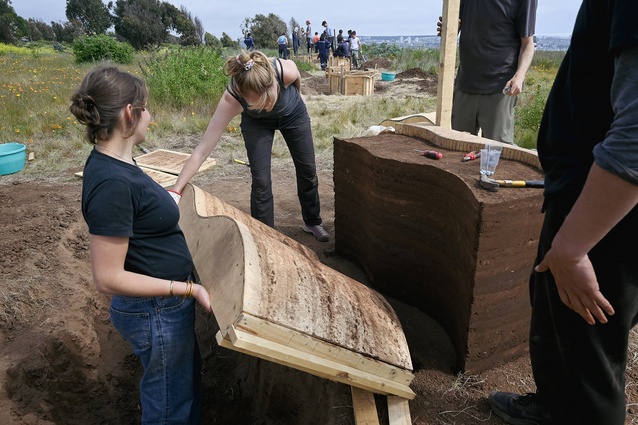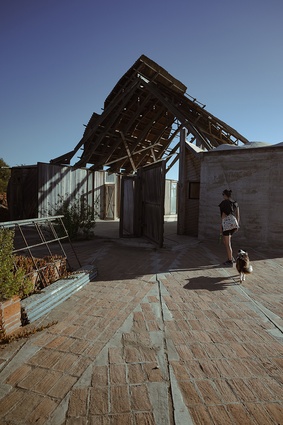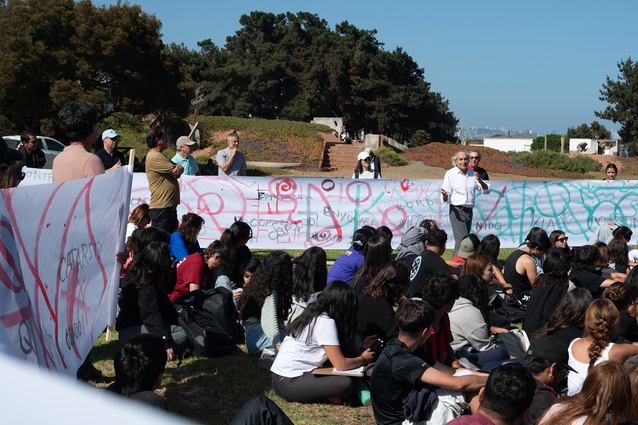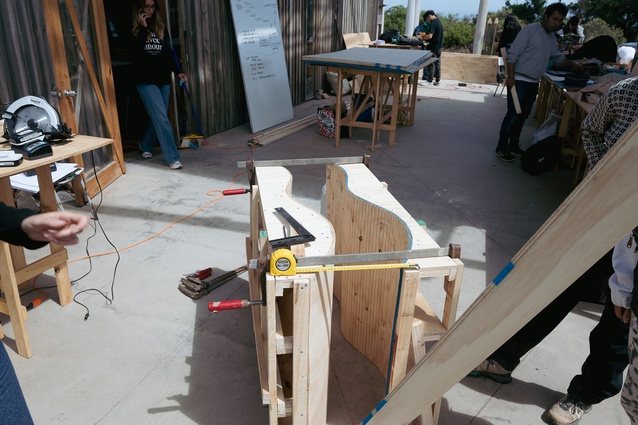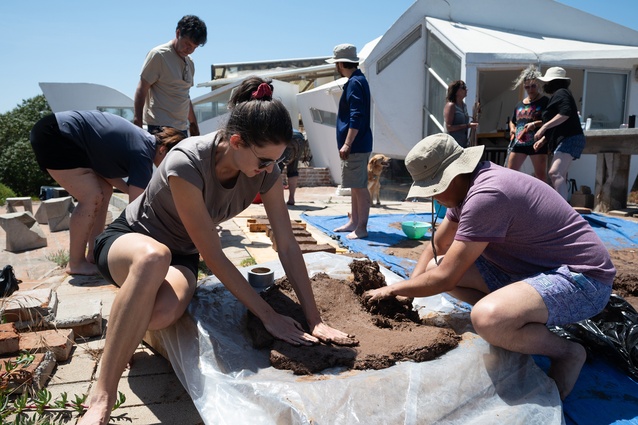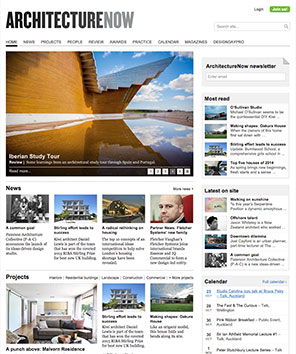pre:fab interview at the Venice Architecture Biennale 2025
The 2025 Venice Architecture Biennale draws to an end on November 23, six months after its launch in May. Aotearoa’s pre:fab were interviewed by The Architecture Lobby for the prestigious event and pre:fab’s Leonard Hobbins and Tessa Forde also collaborated with Chilean architects from ‘The Open City’ on the Hospedería del Teatro project featured at the Biennale. In this interview, Hobbins and Forde ask architects Andrés Garcés and Rodrigo Daine to report back from Venice.
Venice Biennale 2025 curator Carlo Ratti’s call for “a new approach to authorship”[1] in the context of architecture is one familiar to students attending Ciudad Abierta de Amereida in Chile — the “Open City”. Just outside Valparaíso in a coastal dunescape, a collection of poets, sculptors and architects have been physically and conceptually constructing their community together for around 60 years. Ciudad Abierta is also a classroom and design laboratory for the architecture school at PUCV and, over this time, hundreds of the open city’s residents, students and visitors have contributed to the creation of an alternate reality.
The site is recognised historically for its expressive architectural style, an enigmatic bric-a-brac deconstructivism influenced by the contributions of live-in philosophers and poets, as well as annual journeys the school undertakes called “travesías”, which attempt to discover a sense of belonging and identity in South America. But perhaps more significant is the sheer longevity of the project, successful in continuing its optimistic vision over several generations, resisting the imperatives of the contemporary neoliberal university and, before that, the blunt austerity of a military dictatorship. Collective members of Ciudad Abierta meet every week to imagine and strategise the continuation of their community and also to share lunch and chat together, taking turns to cook for up to 50 people every Wednesday for over 40 years. This organising and community strength also allows the school to continue to adapt, currently with a new and renewed focus on natural building technology and social housing. This type of “collective intelligence” has been acknowledged with the inclusion of Ciudad Abierta in the Venice Biennale, showcasing a live studio project called Hospedería del Teatro — a rammed earth community theatre and visitor housing designed and built by a revolving body of professors, students and visitors to the school.
Here in Aotearoa, pre:fab platform is a group of built environment enthusiasts also experimenting with new forms of authorship for architects. pre:fab thinks of their platform like a record label, with artists conspiring to produce work — individually, collaboratively and collectively — that contributes to the creation of a shared identity or brand, thereby uniting the collective as a self-reinforcing cultural production factory, in which its members are the independent authors, initial audience and primary promoters of their creative work.
pre:fab was included in the Venice Biennale this year within the contribution of The Architecture Lobby[2] “Organizing in the Lobby”. The Lobby interviewed organisations around the world that focus on the agency of architecture workers, gathering insights about why architects become organisers, what architecture workers are up against, how organisations position themselves in relation to traditional institutions like institutes and universities or the biennale itself, and what a hopeful vision for the future of architecture workers might look like.
In the interview screening at the Biennale, pre:fab members spoke about the vital role Te Ao Māori has in shaping not only the built environment but also the fundamental approach of our thinking and organisation around institutions. We spoke about pre:fab’s experiences with the NZIA and how we have worked to fill gaps left by the institute, or challenge their approach where needed — pre:fab has run free alternatives to the NZIA’s in:situ conference, produced grant applications for collective housing, made a submission on licensure legislation, and ran for president of the NZIA, presenting a complete vision for reshaping the institute to their board. We also talked about how pre:fab’s focus is in supporting the work and initiatives of our members, and the idea that committed organising is only sustainable when this support is consciously designed and ritualised, as in the example of the 60 years of collective production at Ciudad Abierta de Amereida.
While living in Chile last year, members of pre:fab Leonard Hobbins and Tessa Forde got to work on the Hospedería del Teatro project, prototyping rammed earth construction with the project leader Andrés Garcés (Profesor, Escuela de Arquitectura y Diseño, Pontificia Universidad Católica de Valparaíso) and teacher and resident at Ciudad Abierta, Rodrigo Daine (Profesor asistente, Escuela de Arquitectura y Diseño, Pontificia Universidad Católica de Valparaíso). Here, we asked Rodrigo and Andrés about their experiences working on the construction of the project and presenting the project for the Biennale in Venice.
Glossary of terms
La Ciudad Abierta – The “open city”, an intentional community near Valparaiso set in 200 hectares of arid dunescape on the coast that was formed 55 years ago by a group from the architecture school at PUCV and has operated as an experimental living, building and teaching site.
PUCV – Pontificia Universidad Católica de Valparaíso is the university from which students and teachers from the school of architecture and design founded La Ciudad Abierta.
Travesías – Annual journeys the school undertakes that attempt to discover a sense of belonging and identity in South America. The first such journeys were undertaken by the founders of the open city and informed their sited and interdisciplinary architectural philosophy. Today, hundreds of students from PUCV undertake travesías each year, and a map of all the past travesías covers most of Chile and a large part of the continent.
Hospedería del Teatro – Hospederías roughly translate to ‘guesthouses’. In the open city, they are typically houses where open city residents live but also places for guests to stay, and they generally provide a second function to the community. In this case, the Hospedería del Teatro will incorporate in its design a full scale 8x8x8m theatre space where the community of Ciudad Abierta can attend and perform theatre productions.
Agora – Based on the ancient greek public gathering space, in La Ciudad Abierta the Agora is a landscaped square, demarcated by sculptures at each corner, where the community gathers to make important decisions together, such as whether to admit a member of the corporation to become a full-time resident or whether to undertake a new building project.
Acto poético – The origin point of a project at the open city, the project collaborators compose a poem that defines the field of investigation for the work. This happens through a ‘poetic act’, a kind of game or performance that engages both the physical bodies of the collaborators as well as the landscape where the project will be sited. Sometimes this is augmented with architectural armatures or other materials, such as cords or ribbons, that define spatial relationships.
Taller de obra or Taller – The building studio at La Ciudad Abierta where students from the architecture school in Valparaíso come to learn architecture through making a built work together. Most of the buildings and sculptures at the open city have been built through this collaborative tradition.
La Ronda – a kind of free-form community critique and design charette of the project, where all affected or even tangentially interested parties can voice their input on the direction of the project.
La Observación – a Ciudad Abierta process technique that takes the place of a ‘site visit’, where both abstract poetic cues and physical qualities that will influence the spatial design of a project arise or are divined from the landscape.
Cerros – “hills” in Spanish, the cerros of Valparaiso are also hillside neighbourhoods. The steep geography of the city and historical patterns of development around the port mean that the lower cerros closest to the coastline are the traditional centres of colonial wealth, while as you ascend into the cerros, buildings and developments become less formalised. The fringes of the city in the highest cerros contain encampment communities with no paved roads or services.
Tapial – a traditional Chilean rammed earth construction method.
Quincha – a traditional Chilean earth construction method similar to ‘wattle and daub’ where a clay mixture is applied to a wooden structural frame.
Interview with Andrés Garcés and Rodrigo Daine
The following interview has been translated, edited and condensed.
pre:fab (PF): Curator Carlo Ratti grouped participants in this year’s biennale as representing different kinds of “intelligence”, with your project Hospedería del Teatro, as well as pre:fab’s contribution with The Architecture Lobby, included under the category of “collective intelligence”. How do you understand the importance of collective intelligence in the development of the Hospedería project, and in the ritual practices of Ciudad Abierta more generally?
Andrés Garcés: My experience of La Ciudad Abierta is that it was born as a project that, from its origin, had a collective nature. There was an interdisciplinary vision among the founders, a shared outlook between architects, artists and poets that comes from the origin of La Ciudad Abierta. That seems to me a fundamental aspect.
Another is that La Ciudad Abierta was founded not only by professors of the architecture school but also by students. The school itself [at PUCV] was founded in 1952, but in light of major events in Chile — such as the 1960 earthquake in the South of Chile — a sort of collaboration of professors and students was provoked in the reconstruction of the region.
So, there were a series of earlier experiences that gave shape to a way of working — what we could translate as “thinking through doing.” In other words, an approach where architectural thought is inseparable from architectural making, from building the work itself. I believe that has always been at the base of La Ciudad Abierta from its origin.
For this reason, a large part of the works were created through this equation. If I had to put it into numbers, perhaps 80 per cent of the built works at La Ciudad Abierta emerged this way: from the initiative of one or two professors or members of La Ciudad Abierta — sometimes over many years — they would be joined by contributions from design studios or students at the school. The students would develop a proposal, and later the work would be constructed.
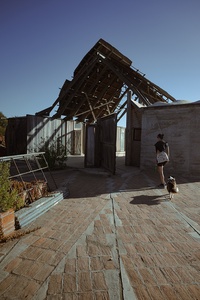
So, that lies at the origin and heart of the proposal of La Ciudad Abierta. Of course, this hasn’t always been the case. It’s not a fixed or absolute condition. In fact, La Ciudad Abierta was born from a student movement in 1967. In a manifesto written by Godofredo Iommi together with professors, they declared that the university was no longer a place of true study — it had been co-opted by other interests, whether political, partisan, economic or narrowly academic. It was necessary, they argued, to go out and look for an “open city” [La Ciudad Abierta] where life, work and study could be practiced freely. That manifesto became a guiding principle and from 1968 to 1970, they sought out a place where that vision could be constructed.
These elements are very important for understanding why today we continue to maintain this rhythm, this way of working. Fifty-five years have now passed since 1970, and along the way, there have been many different ways of building La Ciudad Abierta.
One fundamental aspect is that every work constructed there must pass what we call an approval in “Ágora”, a collective approval from the entire community. Any personal initiative is subject to the community’s approval and it is in the Ágora that it is defined and decided that the work can be made.
Once it’s approved, an acto poético [a poetic act] is carried out. This is the essential rite of La Ciudad Abierta, led by the poets but involving the whole community. I would say that in these acts, the poetic foundations of the work are drawn out. These are not necessarily formal aspects, nor is it like laying a cornerstone, but rather a dimension that illuminates a reflection on the whole creative process of the work.
Having defined this, a taller de obra is formed. Participation is freely accepted — usually members of La Ciudad Abierta but also invited guests. This taller periodically invites everyone to la ronda [a kind of free-form community critique and design charette] so that the project is passed through reflection by the wider community.
This is basically the line of action. Sometimes it works, sometimes it doesn’t. Sometimes la ronda gathers, other times not. That is simply part of the natural conditions of the community, still, we try to ensure that the process is upheld.
A work in La Ciudad Abierta might take two, three, four, even 10 years to complete, or it might remain unfinished. The dimension of life in La Ciudad Abierta is always subject to this creative process unfolding. Personally, I ask myself, “Why do I want to build the Hospedería?” It’s not because I need a building to live in right now. It’s because I want to exercise that process of creative freedom — to think of it slowly, to give ourselves all the time in the world for the work to come into being.
Rodrigo Daine: This theme of collective intelligence, intelligence being the overall focus of the Biennale, from the perspective of the school and my own experience, always comes through the taller, and through the ronda.
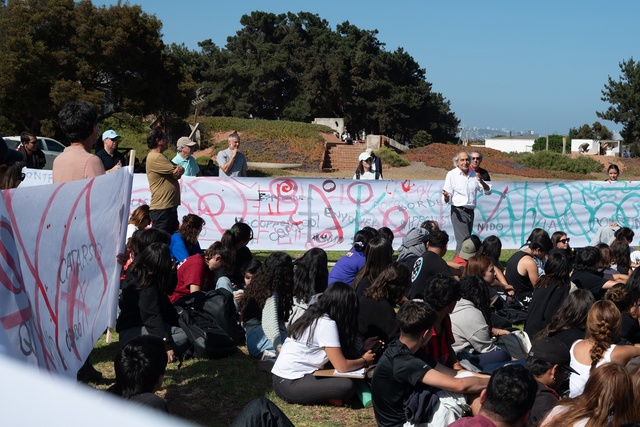
Especially in the case of Ciudad Abierta, it’s about putting yourself in the same creative horizon with your collaborators, across all ages — teachers, students, whoever. Every idea emerges from, and with, another on this horizon. Sometimes it begins with a poetic principle, a game, or something else in this category. But, at some point, something more concrete appears, an idea that, although it still continues to change, isn’t an error — it’s an evolution. It comes through repeated attempts, persistence and a certain creative uncertainty. But, at the same time, suddenly the project can take shape. You have to deliver, to make a model, and the rest is figured out along the journey.
So the experience of collective intelligence, at least from the ronda and from what I’ve seen, is like this: you start with a very clear origin point, and from there you keep moving forward, while keeping that principle in mind but what arises along the way is born from a certain intuition, and that’s the potential of the collective, because everyone contributes something — and those contributions are completely horizontal.
PF: What was your impression of the curation of this year’s biennale as a whole? What was your greatest learning from your experience of visiting and being included in the biennale and how will that influence your practice going forward?
Andrés Garcés: Well, there’s something here as well that carries a kind of historical weight. Both the School of Architecture [at PUCV] and La Ciudad Abierta, from their beginnings up until the 1990s — let’s say up until 1996 — were somewhat isolated from the outside world of architecture, and this date marked a kind of milestone.
That year, the school was invited by the College of Architects of Barcelona to contribute an exhibition. At that time, many of the founders were still alive, not all but a good number. However, in this invitation, an internal reflection was produced about whether what La Ciudad Abierta was, in that moment, could be communicated to the wider world, whether it could really be recounted in other contexts.
I was educated, formed, in a school where the relationship with the world was somewhat cryptic. The older founders, when we told them we wanted to begin the process of doctoral studies, didn’t want us to do it, especially not abroad. They said: “Why? Everything we do, everything worth learning, is already here in La Ciudad Abierta. There’s no need to go anywhere else.” It was a very self-serving outlook.
The school had always held exhibitions every 10 years at the National Museum of Fine Arts, but with a specific dual purpose: to present our work within Chile, to wider society, but also to reflect internally on what the school had accomplished over the previous decade. However, in a way, the school was still very reluctant to take part in biennales or external exhibitions. We rarely accepted invitations to architecture biennales, like the architecture biennial in Santiago, we participated very little.
Then there was a shift. Around 10 of us professors began doctoral studies, and that inevitably changed things. The doctorate, at its intrinsic core, is a field of relationships — you’re spending all your time making references, building networks, forming connections. So, from this, we had the 1996 exhibition, then another in 2002, then the show at the Reina Sofía in Madrid. That was also a turning point because it spoke directly about how events in the Americas paralleled the European avant-gardes. It prompted deep reflection about the weight of this idea, this project, that was the school as well as La Ciudad Abierta. So, the idea to participate in the Venice Biennale is preceded by this series of exhibitions in which we have participated, which built up a kind of momentum for what we had been doing.
It’s also true that we don’t have a commercial structure that pressures us to be in biennales, unlike independent artists, for whom, in some ways, biennales serve as bridges to a certain prestige. So it has been difficult for us to understand that to participate in biennales is something transcendent because it puts what we do into discussion — it puts it into reflection.
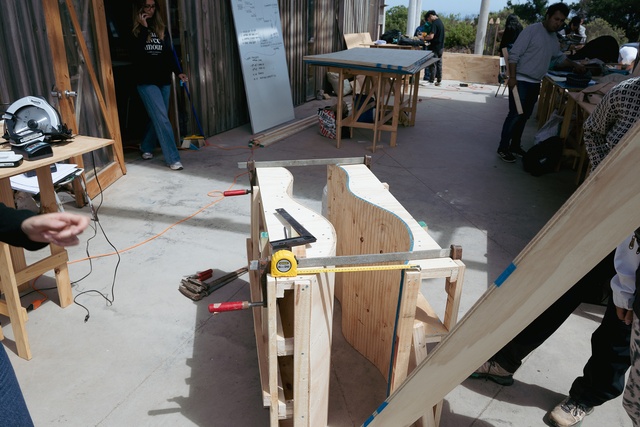
In this sense, I found it important, in today’s world, to see whether what we are doing here carries weight. Sometimes we believe it does, but we don’t really know. La Ciudad Abierta is widely known and published in many places but we want to show a bit of what we do now in actuality, because often when people talk about it, they are talking about a Ciudad Abierta of the past. When people visit, they want to see works from 20 or 30 years ago — the cemetery, other older works. So it was important to bring forward a new idea of work: on the one hand, the collective process, which is crucial and, on the other, a concern that has not been very present in La Ciudad Abierta previously — material sustainability of things. We have super interesting concepts like observación about the relationship of the work to its site, about the idea that the work should emerge from the place. But we don’t have a clear position on materiality — we focus on what we mean by “place” in spatial terms but not material terms.
That’s where this Biennale offered us something very valuable: reflection on new paradigms of how we relate to place, especially in terms of material. That struck me as very important, to go there with the attitude of observing.
Our participation in this biennale is modest, it’s pretty small — it is circumscribed to the curator’s reflection — but, seeing all the people that participated in this process, in this reflection, was super interesting. And we could only see very little! We only had about 10 days, which was nowhere near enough to take it all in.
What I realised is that what we are doing here — despite being so far from everything, Chile is such a peripheral country, and New Zealand, too, perhaps — Chile is on the margins globally, but we are still doing interesting things, we have very good architects. At this Biennale, for example, there was Pedro Alonso’s well-positioned project and Alejandro Aravena’s social housing proposal, which used materials capable of absorbing carbon.
These are important contributions. But, for La Ciudad Abierta and the school, the question is: are we really part of that global conversation? That’s why participation seemed so important to me — to test whether what we are doing is still relevant, and whether it connects to the new collective processes happening today.
And I believe, in some measure, it does. For example, while there were projects working with earth using prefabricated systems or computer-generated systems, there was nothing quite like what we are doing here: incorporating curves into the formwork by hand, generating complex geometries. Using conventional systems, conventional tools and, despite that, generating complex forms. In that sense, I felt that what we are doing here is very interesting and works well in dialogue with what was being presented at the Biennale.
Something that interested me was reflecting on the two formats of the biennale and what they produce. On the one side, there is the Arsenale exhibition, which has the curator’s official selection reflecting on these three forms of intelligence, and we are included in this process. On the other side, the biennale invites individual countries to reflect on the same thing, and each country has to see themselves well represented. For example, one case I found interesting, perhaps a little conventional, more conservative let’s say, but I found the proposal interesting and coherent, was Spain’s pavilion. I thought it was good. They invited 16 offices, collectives, etc., to show what they are doing in the country in regards to resilience, processes of regeneration and recycling. Which was to say, “Spain is working on this”.
In other cases, the country pavilions leaned more toward performative installations, where the country’s curator used the Biennale as an opportunity to put forward a personal artistic proposal. At times, this seemed a bit weak or very abstract. In my view, the Chilean pavilion fell somewhat into that category: yes, it presented a problem, but it didn’t articulate clearly what role architects should play in confronting it. And that, to me, is fundamental. The difference between an art biennale and an architecture biennale is that architecture carries a political and social responsibility in front of the world. After all, architecture and construction are responsible for around 38 or 39 per cent of carbon emissions worldwide. The Biennale is therefore a crucial moment to reflect on climate change.
In that sense, the three “intelligences” proposed by the curators — artificial intelligence (which itself consumes enormous amounts of water and energy), collective intelligences and natural intelligences — pose urgent questions: what is our response as architects? How do we engage collectively? How do we understand nature when we design?
That’s what I found most important and powerful about the Biennale. But, in many cases, the works presented stopped at framing the problem, without offering a clear architectural response. That left them feeling more ambiguous, more like art installations than architectural proposals. That was my impression.
Rodrigo Daine: My first impression, physically speaking, came from small installations. Venice was full of these tiny installations, mostly about climate change, sustainable materials and experimenting with new forms using the same materials. In a way, each installation brought us back to the origins — when humans had more direct contact with nature, with cycles, with a more sensitive awareness of place. Each country tried to show something of this.
When the curators approached the theme of “intelligence”, they divided it into three large pavilions, each about 100 metres by 50 metres. Each pavilion had its own theme. One was the Pavilion of Natural Intelligences, which focused on natural elements and processes, connections with materials, and work with communities. Then there was the Pavilion of Collective Intelligence, where most of the projects were fascinating because they were interdisciplinary. These projects involved collaborations with communities, craftspeople and different studios. Here, what mattered most was how the project was born, rather than the project itself or its final form.
Finally, there was the Pavilion of Artificial Intelligence. The idea was that humanity now has a new digital tool that contributes to creativity, to processes, and throughout every phase of design. That was powerful but, also, unsettling because in some cases it replaced tasks usually done by humans. So, the question became: to what extent do the collective, the individual, the natural, and the artificial intersect? Each pavilion showed a different aspect of this tension.
Personally, I was very focused on what was being done with earth. Spain presented something related to earth. Australia also. And Turkey — Turkey was incredible. They had a catalogue that showed all their processes and attempts: different materials, industrialisation methods, forms, techniques. Not just 3D printing, which was a major trend there, but many other techniques: rammed earth, adobe, quincha. Turkey seemed to be the country that most seriously engaged with raw earth construction, more than others proposing new ways of living with earth — using both more industrialised and less industrialised processes, even modular ones.
For me, that was powerful. And it connected directly to what we’ve been doing in the taller with the Hospedería del Teatro project. In some way, it put us at the forefront, especially in our work with rammed earth.
In short, how will this influence my practice? Mainly by reminding me to keep experimenting, to keep testing — just as I saw there, and to never forget the origins. Countries like Mexico and Australia also addressed ancestral or original techniques and carried them forward into innovation. They didn’t forget their past, but advanced with it into a new present, giving answers with historical consistency that also worked in their own contexts. Mexico, for example, revived the chinampas — floating islands used for cultivation. They had been used 300 years ago, and now they reappeared in the Arsenale hall and in the lagoons, to show that when you make these connections, you can innovate.
At an academic level: in Chile, earth construction is not taught as a technique within architecture. It only appears in restoration programmes, heritage studies or in fields like engineering and construction. Only recently have two or three universities started post-graduate projects that involve earthen construction — at the University of Chile, the University of Talca and, now, a new research centre in La Serena. But it’s just beginning.
At the legislative level, there are still no building codes for earth, even though much of Chile’s historic architecture is built with it. There are gaps — between what exists, what universities teach and the emerging challenges. Progress is being made, but slowly, compared with what we saw at the Biennale. For instance, Turkey is 10 years ahead of where we are. That shows us a possible future, one that says: “Yes, it’s viable, it’s possible, we just need to keep experimenting.”
PF: Why was “tapial” [a traditional Chilean form of rammed earth construction] chosen for the Hospedería del Teatro project?
Andrés Garcés: There are two reasons. One is a personal reflection on architecture. I directed the projects department at the school for almost 15 years, working on public tenders for ministries and municipalities — everything from the Ministry of the Environment to the Ministry of Housing and Urbanism. Throughout Chile North and South.
For instance, after the 2010 earthquake, I worked on reconstruction in the town of Chanco in the Maule region. Maybe you passed through when you travelled south — near Pelluhue. Chanco is a small town near the coast. About 80 per cent of its houses collapsed in the quake so I was commissioned by the Ministry of Housing and Urbanism to design new social housing.
These were built through an “assisted self-construction” programme, meaning families participated in building their own houses. But Chanco had heritage status so, alongside the basic funding for social housing, there was an additional allowance for heritage considerations. The original houses were large adobe mansions — 300 or 400 square metres, part of the local agricultural culture.
After the earthquake, they had to be replaced with 55–60 square metre concrete block houses. This was a constant contradiction: a kind of architectonic reduction of large adobe homes to small, industrialised units, while trying to preserve something of their heritage — whether scale, ornament or layout. It was a difficult project, in that there was a large site with a façade 40 metres long but the habitable spaces behind it were tiny in comparison.
Beyond the technical delivery, the project forced a personal reflection on the way “social” construction projects are supervised by the economic and political aims of industrialisation. Social housing is deeply tied to industry in all its dimensions: the whole system is conceptually tied to industry and is dependent on these arrangements to function.
For example, one thing that happened in Chile was that all the building material supplies had become monopolised by large chains like Home Center and Easy. Local hardware stores went bankrupt because they were unable to access materials.
This created a lifecycle process of construction that couldn’t be sustained. The whole idea of “self-constructed” social housing became impossible because the materials were no longer available locally.
So there’s a big problem: industry delegates the responsibility of building and materials to a macro-process. If I need to build a particular wall, I have no choice but to use 50 bags of cement that, let’s say, arrive from the extreme South of Chile, and then there is an enormous carbon footprint which comes with that.
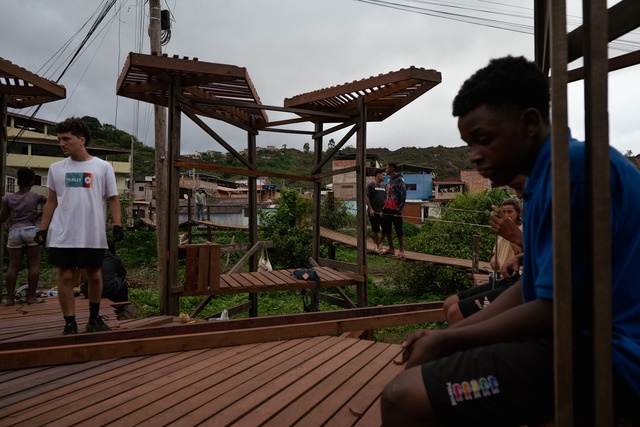
In all the designs we did, this weighed on me as something architects are not always conscious of — that we are creating something that passes along a long projected line, on which arrives materials that come from “I-don’t-know-where”.
So, around six years ago, I began incorporating eco-design concepts into the teaching of our studios, even into the travesías. In 2019, I was invited by the Kawésqar community — an indigenous canoe-going people from Patagonia — to develop a master plan, including an ethno-scientific station, a hotel and a path for the community. For that project, I invited a friend who is an expert in circular economy to help us bring eco-design principles into the very first stages of planning.

In parallel, another important aspect was much earlier, I built my own house in the south of Chile, which you have visited. Here, another paradigm was offered to me in that the house contained no concrete elements at all. Everything was wood — even the foundation posts were set directly into the earth. The only industrial elements were the glass panes and the fixtures. And the wood was all local. In fact, all of the materials came from, or were fabricated within, a 15 kilometre radius of the house. The carpenter lived 10 kilometres down the road and he sourced the wood himself from the same town, and other neighbours also supplied timber directly from their land.
This gave me a sense of closeness to the material and so, in the Kawésqar project, I had the idea that the project should use only local, native timbers. But my friend, the expert in circular economy, challenged me: “Why not use plastic?” he said. From the eco-design perspective, plastic could be more sustainable in terms of durability. If you want a building to last 100 or 200 years, then the material must have that lifespan. So, although I imagined the local timber could reduce the carbon footprint associated with transport etc., if we extrapolate to say everyone will use only local wood, however, the possible extermination of native forests would be a much more potent problem.
That made me reconsider my assumptions. Sometimes the sustainable choice is local; other times it is imported. It isn’t orthodox. It isn’t as simple as saying, “I live in harmony with the earth, I use only what’s at hand.”
I think this is important to bring into the reflection of the school and the formation of the students. This should be discussed in the studio, not only that students should just design a beautiful project — they should think critically about everything that it means to make a project.
That’s where I decided to take this experience of the architecture school studios at La Ciudad Abierta, and change the paradigm. I said “let’s get out of this, let’s get out of this system by any means.” When I arrived at the school as a student, Boris Ivelic [one of the founders of the open city], who you know well, told me: “To change life, you must change your life.” It’s a phrase adapted from Tolstoy. It’s nice, it’s distinct from this idea that to change your life, you have to change the world, which is a much more political vision, instead to change my life, I just have to change myself.
But I still have one foot in each world. My life fluctuates between the system and being outside the system. I always wanted to work in communities, since I was small. In high school, I created a community to work in the cerros in Valparaiso and, when I came here to architecture school at 19 years old, I still had this same idea and I went for a while to live in a naturist commune in the South of Chile. They invited me to be part of their commune and leave everything behind. “Come and join us here and we can work together”, they said. “We’ll work in agriculture and be naturists”, et cetera. And so I would say the decision to change my life was available, I had to make a decision, no?
However, I felt that this change, for me, needed to happen through the practice of architecture, and La Ciudad Abierta showed me how this was possible: to live in a community, and that architecture could be a way to construct community. This was the input I could give as an artist, as an architect.
And, in this sense, tapial has very special attributes, the idea that what you have available from a place can transform itself into the work. It’s a special logic that allows the work to break from the process, the chain of industrialisation. It allows you to come to a site where you want to build, extract the raw material from the site, and to give it a form. This is distinct from other earth construction methods, such as quincha, where in the end you are designing an essential timber structure, you make the wooden screen elements, which allow you to make the forms you want. But, to me, it seemed more interesting that it is possible to work just with the earth, earth and water in the correct proportion, and with this same dirt you can create your form. This I found fascinating.
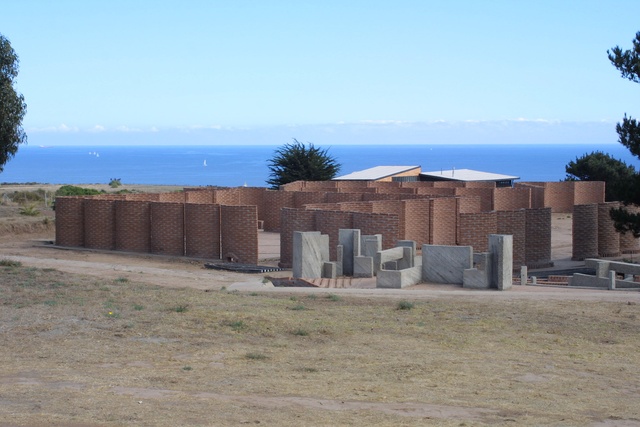
Here in Chile, we have problems with earthquakes, so there is always a kind of background fear of earth construction with no complementary structural materials collapsing. So, we are also investigating how, without adding any other structural material, by curving sections of rammed earth wall, we can counteract moments of inertia in the wall once it is completed. There is a precedent for building like this here in La Ciudad Abierta, which is the Palacio del Alba de Elocaso. In this building, as well as the experiments we are doing now, we are thinking about how to counteract the effects of earthquakes using curved walls and by adding layers of sand in the foundations that move and settle with seismic activity.
This material has a great nobility and it’s also interesting that the input of architecture in this construction is to design the formwork, to make the moulds. The earth component is almost a mass, almost a fluid, a body that is transformed completely. The fun part of this construction is in designing a formwork that has its own qualities — structural, geometric — there is an infinite world of possible work here.
Rodrigo Daine: The use of earth in the Hospedería came from two main reasons. First, because of the site itself — it had a lot of soil suitable for building. And second, because the building needed to sink into the ground. This came from the observación — if not, it would be too exposed to the wind and would require a very heavy envelope. Instead, by lowering it, you protected the work, concealed it and created a new ground. It became an architecture of ground: reshaping the land and then letting those new forms become elements of the project — in this case, the walls.
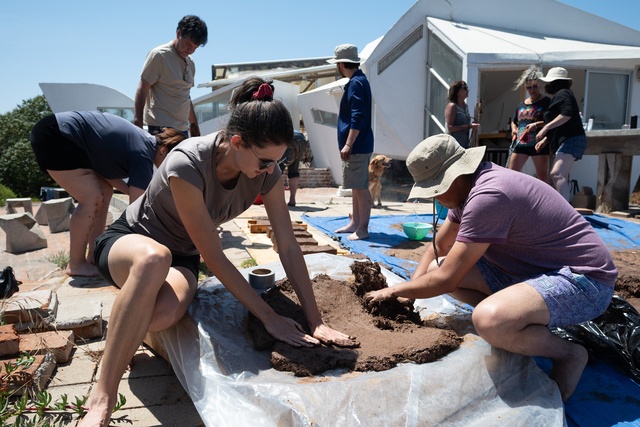
There will also be a mix with timber. We’ll probably use other raw earthen techniques like quincha or adobe — we already experimented with adobe blocks. So, I don’t think we should restrict ourselves to a single technique. Instead, it’s about dialogue between them: where one works best, where another works better, and also considering spatial qualities. That’s been very interesting. For instance, in the last semester of the taller, the students managed to build a minimal floor plan in just a week. Each group had to produce four large adobe blocks and a fragment of space emerged. It was tremendous.
So earth was chosen, first, because of the site conditions. But, also, because of the challenge of working with an economy of materials. What always remains are the formworks but we’ve learned how to reuse them — from the boards themselves to the faces. It’s been a process of reusing materials, calculating carefully, lowering costs and achieving something big with very little. In other words: do less but achieve more.
That’s been the experience with the Hospedería. For example, we did the earthmoving on the site and, through this act, the design of the project changed. That’s where collective intelligence comes in. We started with an initial idea — a poetic act, some spatial criteria — but then the project could change. That’s the interesting part of this kind of intelligence: someone can bring a new idea and, if it’s good, we adopt it. This project remains open-ended. Even though we have models and many versions, more will come. It hasn’t concluded yet.
[1] https://www.labiennale.org/en/architecture/2025/19th-exhibition
[2] The Architecture Lobby (TAL) is a grassroots organization of architectural workers — architects, landscape architects, planners, designers, students, and others — advocating for just labor practices and an equitable (built) environment, operating mostly out of the US.

